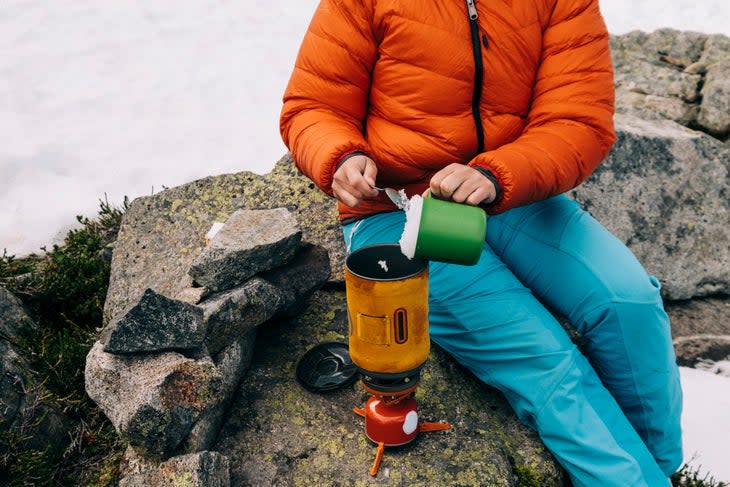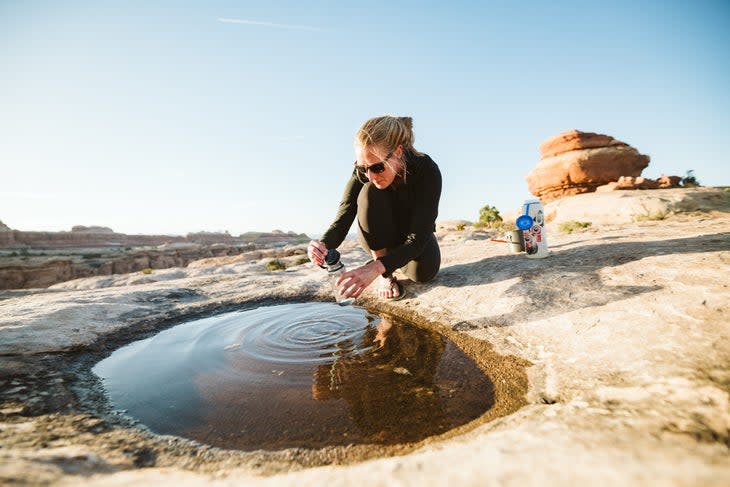A Survival Expert’s Best Tricks for Finding Water
This article originally appeared on Backpacker
In her monthly column, The Survivalist, Jessie Krebs writes about staying alive in dangerous backcountry scenarios. Krebs is a former Air Force S.E.R.E (survival, evasion, resistance, and escape) instructor and owner of O.W.L.S. Skills.
We are bags of mostly water (fellow Trekkies will get the reference). It's necessary for performing virtually every function in our bodies. Even a small drop in optimum hydration levels will impact our ability to think rationally, so finding it early in a survival situation is important.
Water Myths
On average, we can live about three days without water, but that's not a hard-and-fast rule. In some cases, a lack of water could kill a person within 24 hours, while others might last up to a week. It's a common misconception that finding food is crucial to survival, but I never eat unless I have a water source available. Digestion requires a lot of water, and a person can go weeks without food. Eating without water dehydrates you, in effect killing you faster.
The importance of food isn't the only survival myth out there. Perhaps you've seen videos of grisled survivalists chugging their own urine under the guise of staying hydrated. Thirty years ago, in the military, we had a phrase: "People survive in spite of drinking their urine, not because of it." Urine on average has about half the salinity of ocean water, and it’s filled with things your body was trying to get rid of. By drinking it, your body has to pull more water from my tissues to re-eliminate it a second time.
There are enough lessons around disinfecting water to fill multiple articles, but in the end, even dirty water is better than no water. If I have no way to purify wild water, and unless I see evidence to support that it will kill me (like animal carcasses or signs of industrial waste), I drink it anyway. In survival situations, more have died of dehydration because they refused to drink dirty water than from any resulting sickness. Deal with the consequences once you're rescued--it's better than death.
There are a plethora of methods to access water in different environments. The following techniques can come in handy when all else fails.
Melting Snow

Eating snow or ice is like taking two steps forward and one step back. It reduces your body temperature, increasing the risk of hypothermia and forcing your body to heat itself back up--which uses up even more water. Instead, melt it. Note that snow and ice gathered from precipitation sources do not need to be disinfected unless they've been contaminated, while ice and snow from lakes and streams do. If you don't have a stove, use the following methods to melt snow or ice.
Body heat. Place snow or ice in a waterproof container and use the warmth from your body to melt it down. Keep at least one thin layer of clothing between your skin and the container and insulate it from the cold outside air.
Sun. Put snow or ice in or on a waterproof container or material (tarp, rain gear, etc.) and set it in direct sunlight. Place insulation under it if the ground is exceptionally cold.
Fire. Use a metal container (be sure to melt a small amount first, get it close to boiling, and then slowly add more snow, or you may melt a hole in the bottom of your container). Alternatively, hang a pouch made of porous material like a T-shirt or bandana near the fire (I usually use a tripod made out of sturdy sticks) and fill it with snow or ice. Place a clean container below it to collect the water as it drips through.
Animal Indicators
Animal trails can lead you toward water. Look for a V where trails converge: Almost all animals need water, and, as they leave a source they will naturally spread out across the landscape to graze, hunt, forage and so on. When they want water, they funnel back onto main trails to return to it.
Birds generally like to roost near water at night. In a desert environment, watch the sky from a high point an hour or two before sunset. If you see a bird or two flying up high, watch them until they disappear. Note the approximate direction and distance of where they dropped down. If you see several birds come from various directions and all disappear in the same general area, that's even better. The next morning just before dawn, go to the same high place and watch that same spot. If you see birds popping up and flying away from the same area, there is likely water there.
Vegetation
Deciduous trees in a primarily coniferous forest can be an indicator that water is near. For example, aspens like water, but also tend to like well-drained soil, so an inverted V of aspens on a slope can sometimes point to a spring just above the tip of the V. Cottonwood trees also love water and need it to be fairly close to the surface.
Transpiration bags can collect water from trees and shrubs. A by-product of photosynthesis is water, so by placing a clear durable bag like a garbage bag around a lush branch in direct sunlight, you can collect the water it's giving off. Tape up any holes and seal or tie the bag tightly around the branch so water vapor can't escape. (Only try this trick with non-toxic plants.) In the right conditions, a large garbage bag can collect up to 300 mL of water in about three hours. With bags around numerous branches, you can gather up to a liter of water in a day.
In a similar vein, you can use large plastic bags to collect water from scattered vegetation. In dry areas lacking trees, look for green vegetation like tall grasses. Cut the lushest looking plants and put them into a large bag. The sun's heat will evaporate the water from the plants. Pour the collected water through a cloth and into a container to strain out debris and then drink.
In rainforests, large vines can hold a lot of water. Cut the vine a few feet above the ground and hold or tie the ends over a container (in a pinch, you can use rain gear in a hollowed-out divot in the soil). Not all vines produce drinkable water, so if the water is cloudy, salty, bitter, or soapy, discard it and choose another vine.
Land Features

Potholes form in dry washes in desert environments. Exposed bedrock, especially at the base of steeper drops, can form vertical holes in which water and some debris gets trapped during flash floods. Some can be very deep (over 20 feet) and narrow, thus keeping the trapped water shaded and cool like a well. Tie a fist-sized rock and a container to a line and drop it in to collect water. Treat it when possible before drinking.
Seeps, which form when rain falls on a flat mesa and soaks into the sandstone, are another good source of water. Look for a line of alcoves in the cliff sides of mesas, often with a dark line at the back with vegetation and dark streaks.
Digging
It's not as easy as Hollywood makes it look, but digging in areas where water is close to the surface can be fruitful. Near the ocean, dig at the lowest spot behind the first barrier dune (the first hillock usually covered in grasses or vegetation above the high-tide mark). Dig only until you see water seeping in or the ground looking very soggy, then cover it, and check it for fresh water in an hour or so. If you dig too deep, you can go through the thin freshwater table into the saltwater table below and contaminate your source.
In large dry washes, the outside bend of the wash is generally deeper, more shaded, and the last place water flowed. A drop in temperature, the presence of mud, animal tracks, and clouds of small flying insects increase the odds that water is near the surface.
Solar stills can be a bit complicated--you can learn more about them here. I would use these to get water from saltwater or a heavily contaminated source only if I happen to have manufactured stills or the right materials. It can be labor- and material-intensive, and thus is rarely used in survival situations, but it's a possibility when no other option is available.
For exclusive access to all of our fitness, gear, adventure, and travel stories, plus discounts on trips, events, and gear, sign up for Outside+ today.

